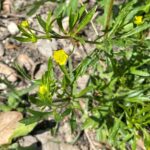Προβατάρης, Ρανούνκουλος της κοιλάδας
Etymology of Ranunculus arvensis: "Ranunculus" in Latin means "little frog" and it is called as such by Pliny either because many Ranunculus species are aquatic or found near water, just like frogs or because many grow where frogs abound. Latin "arvensis" means "from the field, meadow or grassland", and refers to the habitat where it grows.
The Ranunculus genus in Cyprus is rich, with at least 22 kinds (species or subspecies), a little hard to distinguish one from the other. Three of these kinds are exclusively encountered in occupied northern Cyprus.
Ranunculus arvensis basically grows in every region of Cyprus except in the Kerynia region. It is encountered at an altitude of up to 1525 metres. Its flowering period is between March and June.
How to identify Ranunculus arvensis:
It is a terrestrial herb, with leaves exstipulate, its petals are usually yellow and its achenes are not transversely wrinkled; only Ranunculus sphaerospermus and Ranunculus peltatus subsp. fucoides do not bear these characteristics.
All or some of its leaves are compound or deeply lobed; this does not apply only to Ranunculus cytheraeus.
Its flowers are small, rarely exceeding 3.5 cm in diameter; this does not apply to Ranunculus asiaticus.
Its stems are not rooting at the nodes, but they are sometimes diffuse or sprawling; this does not apply to Ranunculus repens.
The flowers of arvensis are solitary, axillary or leaf-opposed; it is an annual plant; this does not apply to Ranunculus paludosus, Ranunculus cadmicus subsp. cyprius, Ranunculus millefoliatus subsp. leptaleus, Ranunculus isthmicus, Ranunculus gracilis, Ranunculus kykkoensis, Ranunculus millefolius, Ranunculus rumelicus, Ranunculus creticus, Ranunculus constantinopolitanus, Ranunculus bulbosus subsp. bulbosus, and Ranunculus neapolitanus whose flowers are terminal and they are perennial plants.
Its achenes are echinate or strongly muricate; this does not apply to Ranunculus chius, Ranunculus marginatus, and Ranunculus cornutus whose achenes are muriculate, papillose or smooth, not echinate or strongly muricate.
The basal leaves are spathulate-cuneate, dentate at the apex. Its upper leaves are with linear divisions, its achenes bear long slender spines, and the achene/margin at right angles to the surface; this does not apply to Ranunculus muricatus whose basal leaves are reniform, deeply 3-7-lobed, its upper leaves sometimes simple, its achenes are shortly echinate-muricate, with a broad flat marginal wing.


